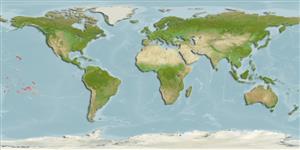Teleostei (teleosts) >
Beloniformes (Needle fishes) >
Hemiramphidae (Halfbeaks)
Etymology: Hemiramphus: Greek, hemi = half + Greek, rhamphos = bill, peak (Ref. 45335).
More on authors: Lay & Bennett.
Environment: milieu / climate zone / depth range / distribution range
Ecology
Marine; pelagic-neritic; depth range 0 - 1 m (Ref. 58302). Subtropical
Pacific Ocean: in the tropical and subtropical waters.
Size / Weight / Age
Maturity: Lm ? range ? - ? cm
Max length : 34.6 cm SL male/unsexed; (Ref. 54980)
Feeds on small fishes, zooplanktons and organic detritus (Ref. 89972).
Life cycle and mating behavior
Maturities | Reproduction | Spawnings | Egg(s) | Fecundities | Larvae
Tinker, S.W., 1978. Fishes of Hawaii, a handbook of the marine fishes of Hawaii and the Central Pacific Ocean. Hawaiian Service Inc., Honolulu. 568 p. (Ref. 583)
IUCN Red List Status (Ref. 130435)
Threat to humans
Harmless
Human uses
Tools
Special reports
Download XML
Internet sources
Estimates based on models
Preferred temperature (Ref.
123201): 25.1 - 29, mean 27.9 °C (based on 148 cells).
Phylogenetic diversity index (Ref.
82804): PD
50 = 0.5005 [Uniqueness, from 0.5 = low to 2.0 = high].
Bayesian length-weight: a=0.00759 (0.00398 - 0.01446), b=3.21 (3.05 - 3.37), in cm total length, based on LWR estimates for this species & Genus-body shape (Ref.
93245).
Trophic level (Ref.
69278): 3.4 ±0.5 se; based on size and trophs of closest relatives
Resilience (Ref.
120179): High, minimum population doubling time less than 15 months (Preliminary K or Fecundity.).
Fishing Vulnerability (Ref.
59153): Low to moderate vulnerability (32 of 100).
Nutrients (Ref.
124155): Calcium = 215 [83, 511] mg/100g; Iron = 1.53 [0.62, 3.71] mg/100g; Protein = 18.2 [15.6, 20.5] %; Omega3 = 0.236 [0.095, 0.691] g/100g; Selenium = 10.4 [4.0, 28.9] μg/100g; VitaminA = 16.2 [3.8, 75.1] μg/100g; Zinc = 1.12 [0.69, 1.87] mg/100g (wet weight);
